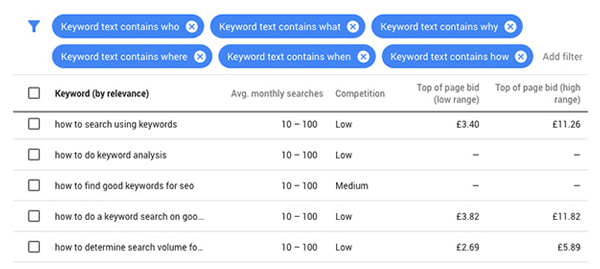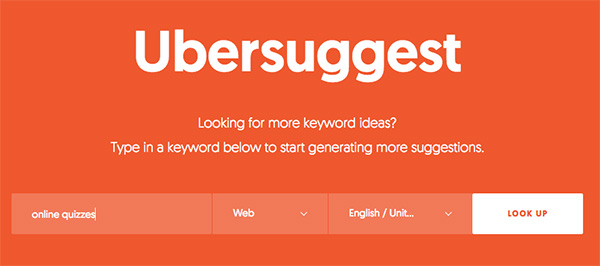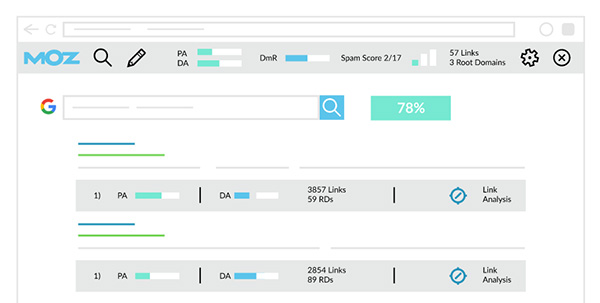- Tools
- Learn
- Help
Before you leave..
Why not download RevGlue latest free eguide.

Last year, a major study conducted by ahrefs found that more than 90% of web pages receive no traffic from Google. That clearly shows an overwhelming majority of business owners don't have an effective SEO strategy. This article explains how to fix that pervasive problem for good and increase organic traffic to your website.
For beginners, SEO is short for Search Engine Optimisation. It simply means a website's content must consider what people search for on Google. That brings us to the single most crucial aspect of an effective SEO strategy: keyword research.
Does keyword research mean finding the popular terms that people google? Yes. But you only need to pick out the most relevant keywords that would not put your web page in a futile competition with behemoths such as Amazon or Wikipedia. Finding those keywords are the only possible way for your content to appear on Google's first page. If it doesn't, 90% of searchers will never see it.
What Are Keywords?

There are two ways to classify keywords: by their size and meaning. When it comes to size, keywords can be categorised into short-tail and long-tail ones. The short-tail keywords are also two-fold: head (one word) and body (usually two or three words). A "dishwasher," for example, is a head keyword, while "buy a dishwasher" is a body one.
Short-tail keywords, however, present SEO strategists with a couple of problems. First, googling them will generate too many results, creating too much competition for pages to rank highly. In other words, apart from unique proper nouns such as your site's name, can you think of any head or body keyword that would bring your content to Google's first page? You can think about it all day, but there is none.
The other issue with short-tail keywords is that they don't reveal much of the searcher's intent. By typing "dishwasher," it's unclear whether the searcher wants to buy, sell or repair a dishwasher. Though body keywords reveal more searcher intent, they often remain too broad to be productive SEO words.
Therefore, the most SEO-friendly keywords that generate relevant traffic to a web page are the long-tail ones. This type comprises at least three words and often discloses the searcher's exact intent, turning it into a reachable target for SEO marketers. Examples of long-tail keywords include "dishwasher repair Arlington, VA" or "coupon to buy a dining table." Anyone typing the first keyword must have a dishwasher problem and the second one probably has his credit card out. Long-tail keywords are the little-known secret to increase online visitors. It's a shame 90% of website owners don't seem to know.
But when it comes to meaning, keywords can similarly be divided into two types: informational and transactional. What are informational and transactional keywords, and why are they essential for an SEO strategy? Transactional keywords are words that represent a service request. These words, for instance, can indicate a user is interested in making a purchase. An example of this word set is "buy," coupon," and "discount."
But Informational keywords are words used to describe the content, and search engines use them when indexing web pages or other sources of information. The users of these keywords are merely seeking some quick answers. Informational keywords might include questions such as"best cheese pizza recipe" and"what is the tallest tower in the world?"
Finding the Right Keyword:

An effective SEO strategy focuses on finding relevant long-tail keywords that make web pages outrank those of the competitors. Remember, only ten links make it to google's first page, and the closer yours is to the top, the more clicks it will get. Essentially, keyword research is a 4-step process. Doing it right will help your site rank highly.
First: Generate a Long List of Short-Tail Keywords:
Bring a piece of paper or open a notes page on your computer. Brainstorm for short-tail keywords by putting yourself in an average consumer's shoes to know what they might google to find your page. Furthermore, you can ask yourself questions such as: what does your content offer? How could your competitors describe you? Write down the answers, and you'll have a list of short-tail keywords.
Second: Convert the Short-Tail Keywords into Long-Tail:
This step expands your list of guessed keywords and turns them into long-tail ones at once. Many free and premium tools can help you conduct this task. They all essentially do the same thing, but the premium tools provide more convenience. How to use the most prominent ones are explained below.
Google Search:
Google is more than just a search engine or a good friend who is always there to answer our questions. It's also a powerful SEO tool. Have you noticed when you input a word, the engine will automatically suggest phrases or sentences? The order in which those keywords are listed determines their trendiness. It's now time to start typing in a guessed short-tail keyword to see what Google will suggest. From the recommended list, use one that best describes your page's content.
Scrolling down to the bottom of the page will get you a group of related long-tail keywords to your query. If the browser has permission to use your location, it will limit the related keywords to your geographic area (i.e., county or city). Furthermore, by clicking on any of those keywords, you will get a whole new list. Replace your guessed keywords with the relevant long-tail ones you find here.
Look at the screenshot below to see search results for a Google user typing in "appliance repair" in Fredericksburg, VA.
Google Keyword Planner

Google's keyword planner (GKP) is another free yet powerful SEO tool, which is fundamentally designed for advertisers. GKP is considered one of the most accurate programs to find keywords. It compiles a list of monthly updated searches specific to your topic or industry. It also provides a variety of data about each keyword, including its popularity and competitiveness.
The following four steps will walk you through the steps to use GKP.
1- Create a GKP account by simply searching for "Google Keyword Planner." Alternatively, you can click this link.
2- In the new window, click "start now." It will then prompt a new window in which you can use your regular Gmail to open an account.
3- At the top, click settings and choose "keyword planner."
4- In the final window, click "discover new keywords" to allow you to type in a keyword in the search box at the top. You must also input your company's URL in the box below to get it to work. Similar to Google Search, GKP will now generate a list of long-tail keywords. But GKP is more advanced because it will also provide some key facts about each keyword that can help you determine which keywords are worth keeping.
Those statistics include the search volume, competition level, and the amount of money Google charges advertisers on a pay-per-click basis for a given keyword. (We will delve deeper into this subject later when we begin to distill our effective keywords.
Ubersuggest:

Ubersuggest is another excellent SEO tool that is available in both free and premium versions. We only use the free version here, but the premium one will allow users to get more specific data. It can also give them a sneak peek into their competitor's SEO strategy. Like GKP, Ubersuggest can expand your keyword list. It's vital to generate dozens of keywords to ensure at least a few of them will pass distillation. It's easy to use this tool: open ubersuggest.com and start inputting a keyword. The website will immediately give you a long list of related ones.
After gathering a long list of keywords, it is essential to look at your competition's keywords using one of the tools discussed. To use those tools, you generally need to do one thing: input your competition's URL. The software will then show the keywords your business rival uses and reveal the top ones that drive traffic to its pages. Ubersuggest and GKP can do that, too.
You can sign up for Social Mention Searcher and Google Alerts to be notified when others mention your brand or that of your competition online. These tools can help you devise a more effective SEO strategy to outrank your competitors.
Third: Distill the effective Keywords
Congratulations! You have finished the most challenging part of keyword research. You now have a good list of long-tail keywords. In this step, we can use the tools we have already discussed in detail. We need only three to five effective keywords for a page to rank highly in Google search results.
But before starting this process, there is another powerful SEO tool that we will use here: MozBar. Use MozBar's Google chrome extension because it will automatically provide vital information below every Google search result. This tool measures your competitors' strengths and weaknesses through page authority(PA)and domain authority(DA). Knowing PA and DA scores is imperative to decide what keywords to keep. Both PA and DA scores are scaled from 1-to-100. While PA pertains to one page, DA score measures the entire website. Higher scores mean greater ability to rank.

The Causes of Low PA and DA Scores

Apart from finding keywords, there are some technical issues every site needs to fix as part of an effective SEO strategy. That includes taking steps to improve your site's PA and DA scores. Those scores are part of Google's criteria for allowing a site to rank highly in its search results.
Top Causes For a Low PA Score:
• Unnatural backlinks: Having no website link to your page or too many backlinks from fake and spammy websites to your page can cause this problem. Google has started penalizing those who try to cheat its metrics by creating many fake links from low-quality websites to their pages.
• Poor-quality content: This includes, of course, poor keyword usage on the whole page, including the title, meta description, and content. In addition to quality keywords, text quantity plays an important role. To meet Google's requirements, a page title should not exceed 60 characters. And a website description should have less than 250 characters.
• Page is not optimized for mobile devices: More than 90% of the world's internet users access it via their mobile phones. If your website is not smartphone-friendly, don't expect your site to rank.
• Duplicate content: You should not have two pages that are exact copies of each other.
Top Causes of Low DA Score:
• Unoptimized images: This means having large images that don't have alt texts to explain what they are. Search engines don't understand pictures without alt text.
• Pages with too many ads.
• Duplicate content across pages.
• Domain penalized by Google: Before setting up a new website, you need to be a bit careful about the domain you want to buy. Some domain names might have previously been used by spammy entities and blacklisted by Google. While you can ask Google for removal from the list, it's less headache to avoid registering such domains in the first place.
• Lack of social media presence and engagement.
Back to the keyword distillation process: you don't need to use all the tools discussed to shortlist the keywords. You can use either GKP or Ubersuggestor any other software you are familiar with. They will all do the job. But first, you need to know two signs of an effective keyword: it has high cost-per-click (CPC)and a large search volume. While nobody is paying more for a useless keyword, a large search volume alone does not necessarily indicate effectiveness. Most searched keywords usually entail high competition. Search volumes are generally measured monthly.
What is a good search volume, then? It is a tricky question because the response depends on many factors, including the popularity of a given page's content. If, for instance, you want to increase traffic to an article about a rare topic or product, then you might not need a highly-searched keyword to bring visitors to it.
In brief, to distill the effective keywords, you will have to do the following four steps:
1- Copy and paste all your keywords into GKP or Ubersuggest.
2- Keep keywords with low to medium competition and medium search volume.
3- Throw away the keywords that have the lowest CPC.
4- Keep keywords that appear most relevant to the content of your page.
After this step, you should be left with about 10-15 keywords. Then comes the final critical step in the distillation process. Type each keyword into google search and look at MozBar's scores for each result on Google's first page. A useless keyword would only lead to pages with high PA and DA scores. As a rule, discard the keyword if most of the PA and DA scores on the page were above 50%. Look for keywords whose PA and DA are lower. In other words, if 8 of the ten results on Google's first page belonged to authoritative companies such as Amazon and Wikipedia, then that keyword is useless. You can never win a competition against those giant corporations.
Instead, look need keywords that bring up so-called hub pages, small business sites, and WordPress sites. The PA and DA scores for those pages are often under 50%. If those pages could make it to Google's first page, so can yours.
Finally: Use the keywords:

We have a short list of excellent keywords. What should we do with them? It is now time for some action. We can use those hard-won keywords throughout our page, including the title, headline, description, and body. They need, of course, to be inserted in a way that keeps the text readable. It's also important to bolden and even italicize some of these keywords to tell search engines they are significant. Make sure your headlines have H1 font sizes and the subheadings used to break paragraphs have H2. These are codes that search engines can understand.
While increasing traffic to your website is vital, a high conversion rate might be more important for website owners that offer services or sell products. Unless you have an educational or news website, you don't want everybody to visit your website. When a potential customer visits your page, it would be a shame to lose them because of a confusing or poorly designed site.
Conclusion:
In brief, keyword research is at the heart of any successful SEO strategy. There are many free and premium tools such as Google Search, Google Keyword Planner and UberSuggest, and MozBar that can help you find the most SEO-friendly keywords that can increase organic traffic to your web pages. The secret is to use the long-tail keywords rather than the short-tail ones because the latter is too broad and involves too much competition. Using the right long-tail keywords can make your site rank on Google’s first page. The fact that 90% of the websites receive no traffic from Google indicates that implementing an effective SEO strategy remains a mystery to most people.